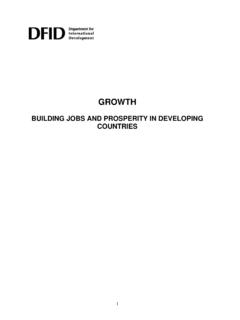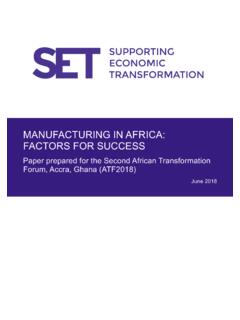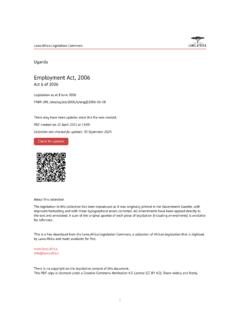Transcription of Wages in Africa - International Labour Organization
1 1 Wagesin AfricaRecent trends in average Wages , gender pay gaps and wage disparities Copyright International Labour Organization 2019 First published 2019 Publications of the International Labour Office enjoy copyright under Protocol 2 of the Universal Copyright Convention. Nevertheless, short excerpts from them may be reproduced without authorization, on condition that the source is indicated. For rights of reproduction or translation, application should be made to ILO Publications (Rights and Licensing), International Labour Office, CH-1211 Geneva 22, Switzerland, or by email: The International Labour Office welcomes such , institutions and other users registered with a reproduction rights Organization may make copies in accordance with the licences issued to them for this purpose. Visit to find the reproduction rights Organization in your in Africa : Recent trends in average Wages , gender pay gaps and wage disparitiesISBN 978-92-2-134155-0 (print)ISBN 978-92-2-134156-7 (web pdf)_____The designations employed in ILO publications, which are in conformity with United Nations practice, and the presentation of material therein do not imply the expression of any opinion whatsoever on the part of the International Labour Office concerning the legal status of any country, area or territory or of its authorities, or concerning the delimitation of its responsibility for opinions expressed in signed articles, studies and other contributions rests solely with their authors, and publication does not constitute an endorsement by the International Labour Office of the opinions expressed in them.
2 Reference to names of firms and commercial products and processes does not imply their endorsement by the International Labour Office, and any failure to mention a particular firm, commercial product or process is not a sign of on ILO publications and digital products can be found at: _____Designed and Printed by: CreMediaPrinted in real Wages have increased by about 20 per cent in Africa between 2006 and 2017, supported by Labour productivity gains. The growth in real average Wages has been slightly steeper in northern Africa (22 per cent) than in sub-Saharan Africa (15 per cent). However, in the most recent years average real Wages appear to have declined, both in northern Africa and in sub-Saharan Africa . Taking Africa as a whole, they have fallen by 5 per cent between 2014 and 2017. This trend is partly attributable to the situation in specific countries that exert a strong influence on the subregional averages. These trends nonetheless still concern only a limited share of the working population in Africa : wage earners represented only about one in three workers in Africa in 2017, though this proportion is slowly increasing.
3 In the same year, men accounted for two-thirds of wage employees, a gender imbalance that has changed little over the previous ten years. According to ILO data, 57 per cent of wage employees in Africa in 2016 were in informal of data from a sample of ten countries highlights a range of situations in terms of disparities among the Wages received by paid employees. For instance, wage inequality appears to be high in southern African countries, but lower in the countries of northern Africa . In Namibia and South Africa , the 10 per cent best-paid employees earn Wages that are more than 20 times those received by the 10 per cent lowest-paid wage earners. In Egypt and Tunisia, the Wages of the top 10 per cent are respectively four times and five times the Wages of the bottom 10 per at the structure of female wage employment, the report shows that female wage employees are often young and better educated than their male counterparts. Many more female than male wage employees work in the public sector and in social services.
4 Female wage employees also appear to be rather polarized with regard to their occupations, often holding either unskilled or highly professional positions. At each educational level, female wage employees are on average less well paid than their male counterparts, in almost all countries. A factor-weighted measure of the gender pay gap, which allows us to control for differences in the composition of male and female paid employment in terms of sector, working time, age and education level, shows that male employees are on average substantially better paid than female employees in almost all the countries legislation, and wage -setting institutions such as minimum wage policies and collective bargaining, can help to address unduly low Wages and wage inequalities. Inclusive collective bargaining frameworks, where collective bargaining agreements cover a large share of employees, are likely to be more effective, as are minimum wage systems with a broad scope of application, adequate minimum wage rates and diligent enforcement.
5 Since they tackle the broad issue of wage inequalities, minimum Wages and collective bargaining can also reduce pay inequalities between men and women, especially when female employees are clustered in low-paying job positions. The inclusion in collective agreements of clauses specifically designed to address the various roots of the differences between men and women in terms of earnings can also help in reducing gender pay International community has stressed the role of Labour income in the sustainable development of both industrialized and emerging economies. As part of the 2030 Agenda for Sustainable Development adopted by the United Nations General Assembly in 2015, Sustainable Development Goal (SDG) target calls for countries to adopt policies, especially fiscal, wage and social protection policies, and progressively achieve greater equality . More recently, the ILO Centenary Declaration for the Future of Work, adopted at the 2019 International Labour Conference on the occasion of the centenary of the International Labour Organization (ILO), has called for the institutions of work to be strengthened to ensure the protection of all workers.
6 This includes in particular the setting of adequate minimum Wages , statutory or this framework, this document, which complements the ILO s Global wage Report 2018/19 (ILO, 2018a), focuses on wage trends in Africa . It depicts the evolution of real average Wages since the global economic crisis of 2008, offering insights into the economic context for the continent and also presenting an overview of existing wage disparities within countries, including those related to gender. This study was prompted by a sustained interest in wage policies in Africa . Over recent years, many African countries that already had legal provisions for minimum Wages have reviewed their policies, while others have implemented new minimum wage systems. This interest is well exemplified by the recent decision of South Africa to implement a national minimum wage , which came into effect on 1 January 2019. Prior to this, a national minimum wage was introduced in 2014 in Cape Verde, and in 2018 in Mauritius.
7 Other countries, such as Kenya and Namibia, have also undertaken reviews and adjustments of their minimum wage policies. The assessment of wage disparities, and specifically those related to gender, can contribute to informing the design of measures targeting the challenges that women are facing in Africa . This seems timely, since the African Union Strategy for Gender Equality and Women s Empowerment 2018 20281 includes the implementation of the protocol to the African Charter on Human and Peoples Rights on the Rights of Women in Africa (better known as the Maputo protocol), which includes the promotion of national laws and judicial systems to achieve and protect wage some publications focusing on earnings at national level are available, there are few comprehensive analyses of trends at continental or subregional level. There is certainly a need for such work to support the regional coordination of wage policies, given the importance, pointed out by certain authors, of wage policy coordination in a context of emerging trade imbalances between countries (Hoffer and Spiecker, 2011).
8 In Europe, minimum wage coordination has been seen as an important component of economic integration, creating a level playing field, and as a way to advance both European economic integration and the idea of the European social model (Fern ndez-Mac as and Vacas-Soriano, 2016).Like the Global wage Report, the present document was made possible by work undertaken by the ILO in partnership with national institutes of statistics and research centres to improve the collection of data concerning the Wages received by workers within African countries (see box 1). In particular, two workshops on wage statistics, bringing together representatives of national statistical offices, were held in 2017 and 2018. These have enabled the computation of better estimates on wage trends for the continent. As a result, data on wage trends were collected from 28 countries. Though these data are still short of comprehensive coverage, they cover 84 per cent of wage employees in Africa in 2017.
9 Moreover, detailed information on the structure of wage employment and wage disparities within ten selected African countries were provided by national household surveys that included questions on Adopted in July 2018 at the 31st Summit of Heads of State and Government in Nouakchott, the following sections, we first describe the trends in average Wages in Africa since 2006, also presenting insights into the economic growth and Labour productivity gains observed since that year. We then examine the evolution of the population of wage earners, in particular in terms of gender composition, before providing an overview of the wage disparities among wage employees within the ten selected countries, with a particular focus on the gender pay gap. The last section highlights policies that can be useful in tackling low pay and pay inequalities, including the differences in pay between women and 1. wage statistics in AfricaThe collection of data on average wagesFor the 2018/19 Global wage Report and the present companion document, a major effort has been made to collect more and better data on Wages and wage growth from economies in Africa .
10 Two regional workshops on wage statistics were held on the continent. The first was held in Cairo, Egypt, in December 2017 and focused on a selection of East African countries, namely Ethiopia, Madagascar, Malawi and uganda , as well as Egypt. The second workshop took place in Abidjan, C te d Ivoire, in April 2018 and gathered data from a number of West African countries, namely Benin, Cameroon, C te d Ivoire, Gabon, Ghana, Nigeria and Senegal. The workshops helped to increase Africa s representation in the Global wage Report. Through a specific questionnaire addressed by the ILO to each country, data on average nominal Wages were collected from 28 countries and data on real Wages from 24 countries. As a result of these efforts, 84 per cent of employees in Africa are covered in the 2018/19 edition of the Global wage Report, representing approximately 91 per cent of the continent s total wage bill though it must be pointed out that these countries do not all produce data on Wages every year.

















